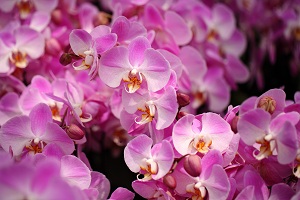 When talking about orchid care, many people use the words “feeding” and “fertilizing” interchangeably. It’s a common assumption that orchid fertilizer “feeds” the plant; but rather than providing a meal, fertilizing your Phalaenopsis orchid is more like giving it a vitamin pill. Like other plants, Phalaenopsis orchids use photosynthesis to create their own food from water, carbon dioxide and the sun’s energy.
When talking about orchid care, many people use the words “feeding” and “fertilizing” interchangeably. It’s a common assumption that orchid fertilizer “feeds” the plant; but rather than providing a meal, fertilizing your Phalaenopsis orchid is more like giving it a vitamin pill. Like other plants, Phalaenopsis orchids use photosynthesis to create their own food from water, carbon dioxide and the sun’s energy.
Orchid roots absorb water from rain and humidity in the air and carry it to the leaves. The plant’s leaves absorb carbon dioxide from the air through pores called “stomata.” The pigment chlorophyll, which gives leaves their green color, absorbs the sun’s energy. Plants use that energy to break down the water molecules in their leaves into oxygen and hydrogen. Some of the oxygen is used by the plant but most is expelled into the air. The hydrogen combines with carbon dioxide in the plant’s cells to create sugar which is what actually feeds the plant.
Fertilizers provide supplemental nutrients that optimize orchid growth. The greatest benefits come from three macro-nutrients:
The three numbers used to label commercial orchid fertilizers indicate the percentage by weight of each nutrient. For example, in an orchid fertilizer labeled 20-20-20, 20% of the total mix would be nitrogen, 20% phosphorus and 20% potassium. “Complete” fertilizers contain all three macro-nutrients. “Balanced” fertilizers contain identical percentages of each macro-nutrient.
Check back next time as we discuss choosing the right fertilizer for your orchid.

Copyright Just Add Ice® Orchids 2023